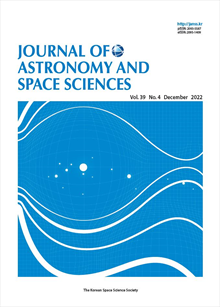간행물
Journal of Astronomy and Space Sciences KCI 등재 SCOPUS

- 발행기관 한국우주과학회
- 자료유형 학술지
- 간기 계간
- ISSN 2093-5587 (Print)2093-1409 (Online)
- 수록기간 1984 ~ 2022
- 주제분류 자연과학 > 천문학 자연과학 분류의 다른 간행물
- 십진분류KDC 443DDC 520
권호리스트/논문검색
제28권 4호 (2011년 12월) 12건
1.
2011.12
서비스 종료(열람 제한)
2.
2011.12
서비스 종료(열람 제한)
We investigate the sunspot area data spanning from solar cycles 1 (March 1755) to 23 (December 2010) in time domain. For this purpose, we employ the Hilbert transform analysis method, which is used in the field of information theory. One of the most important advantages of this method is that it enables the simultaneous study of associations between the amplitude and the phase in various timescales. In this pilot study, we adopt the alternating sunspot area as a function of time, known as Bracewell transformation. We first calculate the instantaneous amplitude and the instantaneous phase. As a result, we confirm a ~22-year periodic behavior in the instantaneous amplitude. We also find that a behavior of the instantaneous amplitude with longer periodicities than the ~22-year periodicity can also be seen, though it is not as straightforward as the obvious ~22-year periodic behavior revealed by the method currently proposed. In addition to these, we note that the phase difference apparently correlates with the instantaneous amplitude. On the other hand, however, we cannot see any obvious association of the instantaneous frequency and the instantaneous amplitude. We conclude by briefly discussing the current status of development of an algorithm for the solar activity forecast based on the method presented, as this work is a part of that larger project.
3.
2011.12
서비스 종료(열람 제한)
4.
2011.12
서비스 종료(열람 제한)
5.
2011.12
서비스 종료(열람 제한)
6.
2011.12
서비스 종료(열람 제한)
7.
2011.12
서비스 종료(열람 제한)
8.
2011.12
서비스 종료(열람 제한)
The total electron content (TEC) using global positioning system (GPS) is analyzed to see the characteristics of ionosphere over King Sejong station (KSJ, geographic latitude 62°13′ S, longitude 58° 47′ W, corrected geomagnetic latitude 48° S) in Antarctic. The GPS operational ratio during the observational period between 2005 and 2009 is 90.1%. The annual variation of the daily mean TEC decreases from January 2005 to February 2009, but increase from the June 2009. In summer (December-February), the seasonal mean TEC values have the maximum of 26.2 ± 2.4 TEC unit (TECU) in 2005 and the minimum of 16.5 ± 2.8 TECU in 2009, and the annual differences decrease from 3.0 TECU (2005-2006) to 1.4 TECU (2008-2009). However, on November 2010, it significantly increases to 22.3 ± 2.8 TECU which is up to 5.8 TECU compared with 2009 in summer. In winter (June-August), the seasonal mean TEC slightly decreases from 13.7 ± 4.5 TECU in 2005 to 8.9 ± 0.6 TECU in 2008, and the annual difference is constantly about 1.6 TECU, and increases to 10.3 ± 1.8 TECU in 2009. The annual variations of diurnal amplitude show the seasonal features that are scattered in summer and the enhancements near equinoxes are apparent in the whole years. In contrast, the semidiurnal amplitudes show the disturbed annual peaks in winter and its enhancements near equinoxes are unapparent. The diurnal phases are not constant in winter and show near 12 local time (LT). The semidiurnal phases have a seasonal pattern between 00 LT and 06 LT. Consequently, the KSJ GPS TEC variations show the significant semidiurnal variation in summer from December to February under the solar minimum between 2005 and 2009. The feature is considered as the Weddell Sea anomaly of larger nighttime electron density than a daytime electron density that has been observed around the Antarctica peninsula.
9.
2011.12
서비스 종료(열람 제한)
10.
2011.12
서비스 종료(열람 제한)
Kim, Jae-Hyuk, Jo, Jung-Hyun, Choi, Jin, Moon, Hong-Kyu, Choi, Young-Jun, Yim, Hong-Suh, Park, Jang-Hyun, Park, Eun-Seo, Park, Jong-Uk
11.
2011.12
서비스 종료(열람 제한)
Choi, Jin, Jo, Jung-Hyun, Choi, Young-Jun, Cho, Gi-In, Kim, Jae-Hyuk, Bae, Young-Ho, Yim, Hong-Suh, Moon, Hong-Kyu, Park, Jang-Hyun

